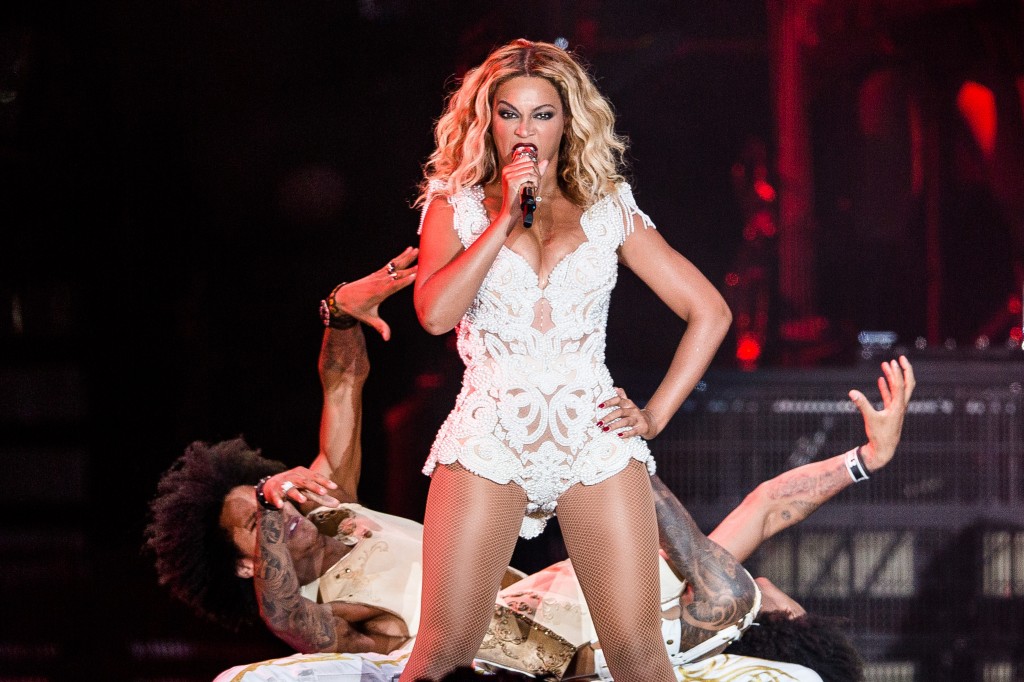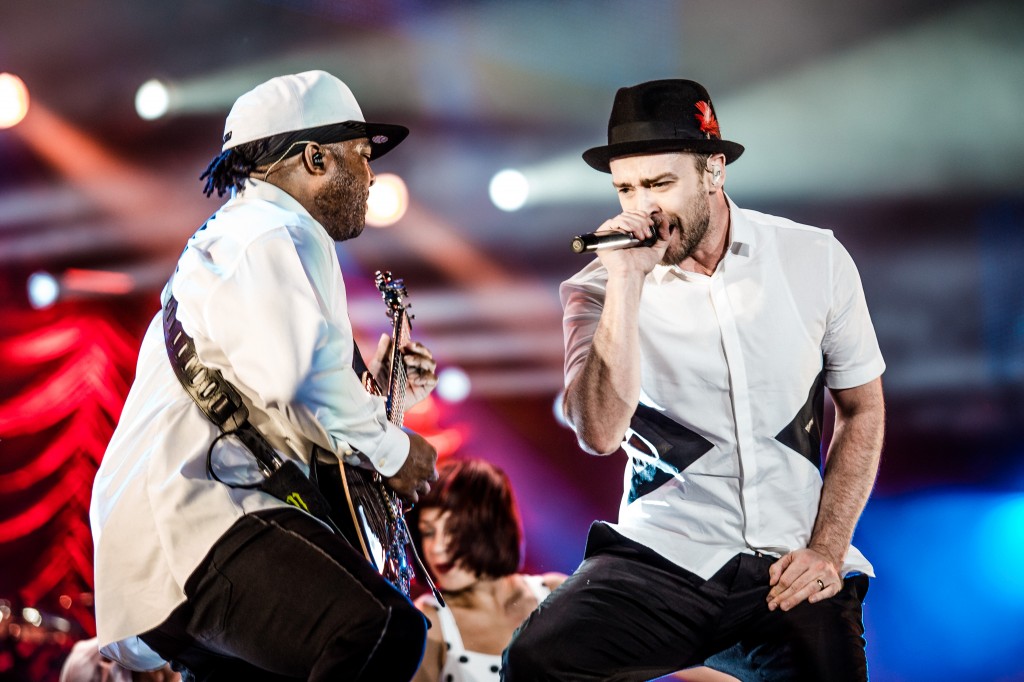The metallic stage shone in the sun as people walked into the Rock City (Cidade do Rock) armed with sun glasses and phone cameras, already posing for each other excitedly. The grass was chemically green, obviously fake and mud-proof, but it still gleamed in the sun, raising the spirits of festival-goers on the first day of Rock in Rio in Rio de Janeiro, Brazil.
It all started in 1985 when the population of South America rarely got to see their rock and roll idols onstage. In ten days 1.4 million people went to the Rock City, the official Rock in Rio location, to participate in the first music festival in South America.
The photos are an indication of delayed festival spirit: people dressed as hippies, bandanas around their heads and huge oversized glasses were the general style of the public. Everyone was unprepared for the inevitable mud despite worries over the state of the city in general. And if you weren’t dirty enough street vendors were selling bags of dirt, which they guaranteed were ‘official Rock in Rio mud’.
Muddy from head to toe, the festival goers felt they were officially initiated into rock after years of yearning to seen their favourite international rock bands play. Brazil was in a bad economic situation which meant there weren’t any companies bringing international musicians to perform – Brazilians were rockers in need and Rock in Rio brought the craved for music home.
In 2013 Brazil is in a much better financial position and receives international bands and music stars on a regular basis. But the newness of festivals didn’t wear off – perhaps because Rock in Rio wasn’t put on in Brazil for ten years until 2011 – as new generations of festival goers excitedly walked around the City of Rock.
Rock in Rio 2013 started on Friday, September 13th. Superstitions didn’t cloud the day, it was sunny and warm – the only problem was the herculean task of getting to the festival. Whatever chosen transport will take almost three hours to get there but in general the public buses are very well organized. The City of Rock is located in Jacarepaguá, a place that feels as far away as Narnia.
The festival has three stages: Palco Mundo (World Stage), Palco Sunset (Sunset Stage) and Palco Eletronico (Electronic Stage). There are also many other attractions like a rollercoaster, a Ferris wheel, numerous stalls giving out free stuff and an awesome zip-line that goes across the audience in front of the biggest stage.
Unfortunately the waiting times for the attractions are ridiculously long: the queue for the zip-line was four hours long and kept going during performance, so you ran the risk of missing out on seeing bands while waiting. But then, you can also have the chance of zipping down across the public during a 30 Seconds to Mars performance. And you might even run into Jared Leto who insisted on hovering over the public himself during the gig.
The Sunset Stage kicked off the festival at 14:30 with Brazilian rapper Flávio Renegado, accompanied by the Portuguese band Orelha Negra. This stage is mostly reserved for less mainstream artists like Living Colour and Angélique Kidjo and Brazilian musicians, though is did receive The Offspring and Sebastian Bach from Skid Row.
The real expectations lay on the World Stage that would receive headliner Beyoncé later that day. Performances in the biggest stage of the festival started with a homage to Cazuza, a Brazilian singer and composer who sung in the first Rock in Rio. He died of AIDS a few years later and is hailed as one of the best musicians and performers in Brazil. The homage had Brazilian artists performing Cazuza’s songs but for all that he stands for the performance wasn’t very impressive and spiritless at best.
Ivete Sangalo’s show was flawless and powerful like usual. Ivete is one of Brazil’s great stars, she sings the Brazilian music genre called ‘axé’, a Bahia-originated Afro-Caribbean fusion. She is remarkable, dancing and running the whole time, making the crowd jump. After her show she climbed down the stage into the audience to enjoy David Guetta and Beyoncé (top photo) with the people.
The lights for Guetta’s set were trippy and the music itself was surprisingly fun to dance to. It is difficult to understand how a DJ, who spins records onstage, doesn’t sing and doesn’t quite perform, can bring such energy to a set of recorded songs. His set wasn’t just a drone playing songs that miraculously fit together – it was fun.
And then Beyoncé took the stage. She is one of the best performers in the music industry – if not the best – and didn’t disappoint for one second. Her moves were sharp, her voice was smooth and fierce at the same time, and her band’s arrangements were bang on. Her choice to name her tour The Mrs Carter Tour has been much criticized by feminists who believe she in enforcing the idea of male-ownership, but seeing her take on the name onstage is another story. Confident and seemingly incredibly happy with her life and herself, she seductively orders the crowd to say “Hey, Mrs Carter!”, a name she has proudly chosen to take on.
Every aspect of her set showed that Beyoncé owns the stage and the audience. The crowd went wild from the first song to the last but of course there were highlights like the “I Will Always Love You/Halo” mash up and the always expected “Crazy in Love”. To finish her set Beyoncé danced to “Passinho do Volante”, a popular Brazilian funk song with a heavy dance beat.
The next day was a happy one for those who wanted to see band perform: Capital Inicial (a legendary Brazilian band), 30 Seconds to Mars, Florence and the Machine and Muse. This is when Jared Leto memorably insisted on zipping down the audience. Florence’s performance was theatrical and full of soul, and although the audience didn’t know most of the songs they were won over, with the set climaxing with “The Dog Days Are Over”.
The third day of the festival was dedicated to pop music, with a subpar performance by Jessie J who stayed in her comfort zone by clinging to her usual hits and failed to cheer up the crowd. The real expectation of the night was Justin Timberlake and the Tennessee kids who were clearly having a blast onstage. This was Timberlake’s first solo performance in Brazil – the last time he was in Brazil, coincidently in Rock in Rio of 1991, was with ‘N Sync, twelve years ago.
Timberlake’s set was a rough draft of his new tour to promote his latest album, ‘The 20/20 Experience’ – but there was nothing rough about it. It was like he had never taken a hiatus at all.
The festival has two days dedicated to heavy metal bands. On the Thursday Metallica, Alice in Chains, Ghost BC and Sepultura rocked out for the heavy rock fans, and Iron Maiden, Avenged Sevenfold, Slayer and Kiara Rocks finished up the festival with a bang on its last Sunday.
The most lukewarm performances happened on the second Friday of the festival when bands on the more average side of quality took the stage. Matchbox Twenty’s performance was tentative, it was apparent that they had never catered for an audience that big who hadn’t exactly listened to any of their albums. Thankfully for them their hit from 2003 ‘Unwell’ was still fresh in everyone’s minds and guaranteed a somewhat salvaging climax.
When Nickelback took the stage next it was clear that they made their research on what their biggest hits had been in Brazil, digging up their 2001 hit ‘How You Remind Me’. Though their music is simple poppy rock it was obvious they can rock out with their guitars, jamming with heavy chords for just the right amount of time. It was probably the most inspired performance of the night, a surprising feat as Bon Jovi was next.
It was an unhappy night for Bon Jovi, perhaps because their drummer was in hospital and his replacement made some blatant mistakes throughout the set. The band was completely out of synch with each other, struggling to make people dance by denying what we all came to hear: the hits. Jon Bon Jovi himself was robotic, like he is getting tired of gigs and his moves have been too well-practiced. It was lukewarm, boring and very disappointing – although in the end they played ‘Livin’ on a Prayer’ and ‘You Give Love a Bad Name’. Thus Bon Jovi concluded a night of music that was only salvaged by the energy of the crowd when the most popular songs were sung.
The expectations for Saturday became much higher after the disappointing Friday but the night began once again with barely known artist who no one cared much about: Philip Philips. His set was uninteresting and, inexperienced for the magnitude of the gig, he struggled to make anyone care about the songs on his only album The World from the Side of the Moon, released in 2012. He would have done better in he had performed in a smaller stage.
But the night was set to get better as John Mayer started playing. He really exudes talent and stirred up many of his (mostly female) fans as he masterfully played his guitar. In general he didn’t move around much even though the World Stage had plenty of room. His guitar solos were a bit too long and it seems he hasn’t quite placed himself in a certain genre of music, alternating between country rock, pop rock, acoustic rock and soul. It could be that John Mayer’s music genre is just John Mayer.
The biggest attraction of the night was to come, and it was undeniably the best performance of the whole festival. Bruce Springsteen, the Boss, and the E-Street Band, owned up to his nickname by giving the most energetic, entrancing, interactive performance I have ever had the pleasure to watch. He is a performer who really understands that he would be nothing without his public and works hard to give the people their money’s worth. His sets are usually three and a half hours long but because of time constraints it came short of three hours.
One of the best moments of the performance was when Springsteen gave his microphone to a little kid to sing the chorus of ‘Waiting of a Sunny Day’. The kid knew all the lyrics and boldly called to the band after he was done: “Come on, E-Street Band!”
Springsteen went way over his allotted time, playing even after the nightly fireworks, which signifies the end of the night, went off. It was undeniably the best performance in the whole festival.
And so the saga to get back home begins. The journey back isn’t as gruelling since there are virtually no cars on the road at four in the morning. But walking to the bus stop (arriving by car is impossible, don’t even try) is the hard part, achy legs, sleepy eyes, but with a sense of accomplishments from having experienced the best in music in only seven days.
Photo credits from event website for press use: Beyonce, Justin, Bruce.











